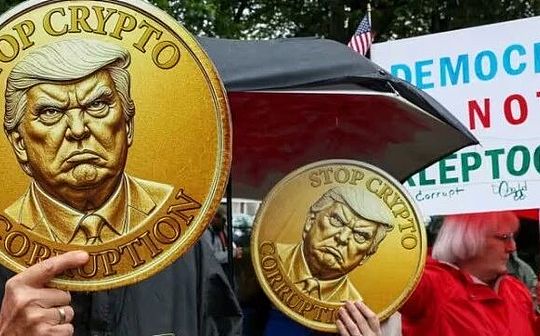
Author: Yuan Biao
01introduction
After a lapse of seven years, the South Korean government announced the abolition of the previous ban.Re-allow crypto-asset-related companies to apply for venture capital funds.This will undoubtedly have a significant impact on the infrastructure construction of South Korea’s crypto asset field.
I have to thank one person for the lifting of the ban.President Gandhi Lee Jae-myung of South Korea.In addition to the lifting of the ban on crypto-asset investment this time, President Lee Jae-myung also led the Korean people to lift the absurd martial law in December last year.Today, 10 months later, when I think back to the political farce in front of Seoul’s Gwanghwamun Gate that night, no one could have imagined that it would lead to the world’s most radical cryptocurrency policy, the Digital Asset Basic Act. To a certain extent, without the martial law that night, there would be no President Lee Jae-myung, and without President Lee Jae-myung, there would be no lifting of the ban on crypto-asset companies applying for VC.What impact will the promulgation of the “Digital Asset Basic Law” have on the Korean financial sector?What lessons can be learned from the Chinese government’s policy decisions in the field of crypto assets?
02Korean background review
Before delving into these two issues, we need to first understand the current development status of crypto assets in South Korea.According to the International Monetary Fund (IMF), South Korea is the 13th largest economy in the world.South Korea’s nominal GDP in 2025 will be approximately US$1.79 trillion, ranking fourth in Asia, second only to China, Japan and India.However, the public’s awareness and participation in crypto assets are far ahead of China, Japan and India.So far, the number of people in South Korea holding cryptocurrency accounts has reached 16 million, exceeding the number of domestic stock investors for the first time.We need to know that the total population of South Korea is only 50 million.That is to say, nearly one-third of the population is participating in transactions in the currency circle.
03Reasons for national currency speculation
There are many reasons for the phenomenon of nationwide currency speculation in South Korea.The author personally believes that, in addition to South Korea’s technological maturity in the field of encryption, it is largely due to changes in social structure in recent years.Problems such as unemployment, aging, and population growth have become chronic diseases of this society.Traditional investments such as funds and stocks have meager returns, real estate is unaffordable, and the long-term sustainability of the national pension system is also in question amid negative population growth.The entire society has been relatively solidified and there are almost no other ways to create wealth.In turn, currency speculation has become a must-have for Korean investors.
04Compare the current situation in China
Compared with the current situation of South Korea’s social structure, how does China’s current situation perform?
In terms of population structure, although South Korea has entered a super-aging society, China is also in the stage of a deeply aging society.Especially after several years of epidemic prevention and control, the sustainability of the national pension system will face greater challenges.In addition, judging from the comparison of deposit interest rates between China and South Korea in recent years, South Korea’s time deposit interest rates are generally slightly higher than China’s RMB time deposit interest rates.In 2024, according to the listed personal deposit interest rates released by the Bank of China on October 1, 2024, the 1-month, 3-month, 6-month, and 12-month time deposit interest rates in South Korea are 2.00%, 2.20%, 2.30%, and 2.40% respectively, while the RMB time deposit interest rates of the same period are 1.00%, 1.05%, 1.10%, and 1.20% respectively. South Korea’s time deposit interest rates are significantly higher than those in China.Although there is no comprehensive official overall data for this year, according to information from Dark Horse, the annual interest rate of Korean time deposits in 2025 will be approximately 1.2%. Referring to the situation in 2024, it is expected that the interest rate of Korean time deposits may still be higher than the interest rate of Chinese RMB time deposits.
05The impact of the enactment of the bill
In this context, Korean investors, especially those between 30-50 years old.Cryptoassets have long been viewed as essential financial infrastructure.The Lee Jae-myung government has also followed the trend and adopted a loose policy towards cryptocurrencies.The author believes that the Chinese government’s relaxation of cryptocurrency trading is just around the corner.So it is decided that cryptocurrency transactions can occur legally in China. China and South Korea are facing the same problems – concerns about speculation, money laundering, and capital outflows.
The fundamental purpose of the cryptocurrency agenda formulated by the Korean government this time is to prevent Korean assets from flowing abroad through U.S. dollar-denominated digital assets such as USDT or USDC.In the first quarter of this year, South Korean cryptocurrency exchanges transferred more than $60 billion in digital assets overseas, of which 47.3% were outflows through stablecoins.The “Digital Asset Basic Law” implemented this time establishes a regulatory framework for Korean companies to issue stable coins linked to the Korean won.At the same time, it also greatly reduces the threshold for entering the stablecoin market.
So can the implementation of the Korean won stablecoin really prevent capital outflows?
The Lee Jae-myung government’s implementation of the Korean won stabilization ratio strategy is not an administrative intervention in the buying and selling of Korean investors’ digital assets denominated in US dollars.Instead, they need to arm their own forces and compete openly with USDT and USDC on the frontal battlefield.South Korea is reducing domestic investor demand for U.S. dollar stablecoins by offering its advantages in programmability, access to decentralized finance, and 24/7 trading without the need for currency exchange.More importantly, at the same time, the financial infrastructure can be kept in South Korea, and handling fees, custody services, etc. all flow to Korean institutions instead of Circle or Tether.This is a behavioral guidance rather than an administrative capital control. It makes the choice of Korean Won denomination more convenient and puts financial operations under Korean supervision.
06Lessons for China
The Chinese government has long maintained a negative attitude towards crypto-assets and virtual assets based on concerns about capital outflows and foreign exchange controls.Especially on September 15, 2021, ten ministries and commissions including the People’s Bank of China jointly issued the “Notice on Further Preventing and Dealing with the Risks of Speculation in Virtual Currency Transactions.”It almost completely denies the legality of crypto asset trading.However, through wait-and-see and research in recent years, the Chinese government’s attitude has also undergone subtle changes. Especially at this year’s Shanghai Cooperation Organization Tianjin Summit, stablecoins and digital currency cooperation were included in the discussion topics.But it does not mean that individuals are allowed to participate in digital currency investments at will, but that the application of related technologies is explored within a compliance framework.
Many years ago, the South Korean government also adopted restrictive measures in dealing with this new field, prohibiting enterprises, institutions and financial companies from opening cryptocurrency exchange accounts.However, individuals were still allowed to use verified real-name accounts to conduct cryptocurrency transactions.Institutional and corporate accounts are prohibited, and banks face strict compliance obligations.It took several years before the South Korean government allowed non-profit organizations and some public institutions to monetize cryptocurrencies obtained through donations or seizures, but they must use verified Korean won real-name exchange accounts and set up internal audit committees.
The development of things always requires a process.Currently, China’s attitude toward RMB stablecoins is generally “strictly prohibited in the mainland and regulated in Hong Kong as a pilot”. Overall, it is strictly supervised based on the consideration of maintaining financial sovereignty and stability.The details are as follows:
-
Strictly prohibited in the Mainland:According to the “Notice on Further Preventing and Dealing with Speculation Risks in Virtual Currency Transactions” issued by the People’s Bank of China and other ten departments in 2021, overseas stable currencies such as Tether (USDT) have the same nature as virtual currencies such as Bitcoin and do not have the status of legal currency, and related business activities are illegal financial activities.This ban covers the entire chain of activities of overseas stablecoins in the country, including prohibiting transactions and exchanges, strictly prohibiting overseas exchanges from providing services to domestic residents, and cutting off the connection between financial institutions and stablecoin businesses.At the same time, the issuance of stablecoins by domestic enterprises is also strictly prohibited, and it is classified as “illegal issuance of tokens and tickets.” Related business activities are illegal financial activities, and intermediary services such as providing technical support for issuance activities are also prohibited.
-
Hong Kong Standardization Pilot:Hong Kong will implement the Stablecoin Ordinance from August 1, 2025, and implement a stablecoin issuer license system, which requires issuers to have a paid-in capital of no less than HK$25 million, maintain 100% high-quality liquid asset reserves, and accept independent custody and daily audits.Companies such as JD Coin Chain have entered the sandbox testing stage, and the pilot scenarios cover cross-border payments and other fields.However, Hong Kong’s stablecoin business has a “domestic firewall” that prohibits licensed issuers from providing services to mainland residents, and the stablecoins they issue are not allowed to circulate within the country.
This model of “offshore pilots and strict domestic controls” not only accumulates experience for China’s exploration of stable currency supervision, but also effectively isolates the financial risks that innovation may bring.At the same time, by promoting the internationalization of digital renminbi and other measures, China is taking a proactive approach to respond to global digital financial competition and participating in the formulation of international rules while ensuring financial security.
07Conclusion
The effectiveness of the cryptocurrency policy strategy launched by the Lee Jae-myung government will have an important impact on the world, especially other Asian economies including China.Coordinating the domestic and international situations is the basic experience of the Communist Party of China in governing the country.We have reason to believe that China’s policy exploration in the field of crypto-assets will always aim to maintain national financial security and promote high-quality economic development, and find a path that is consistent with its own national conditions.






